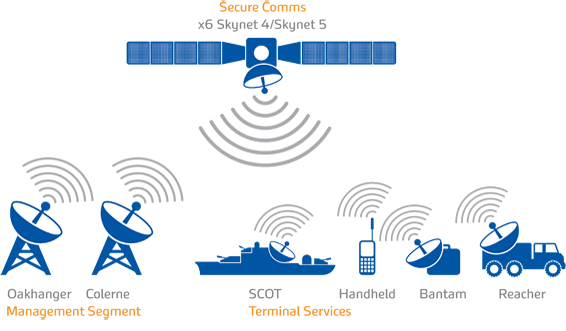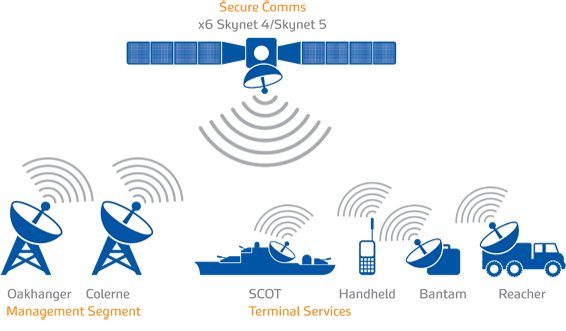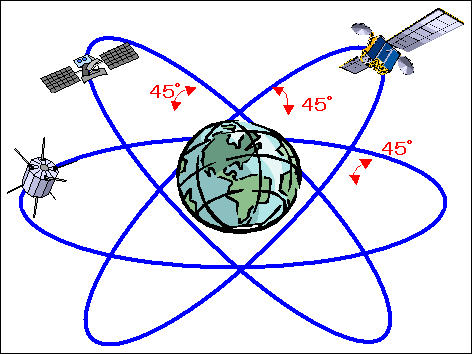Geosynchronous Satellites have now become almost synonymous for communications satellites, because of their wide use in telecommunications due to the advantages over non-geosynchronous satellites. Because of the availability of a number of communication satellites over the geosynchronous arc, the communications between different parts of the world have become possible and affordable. The communication satellites have played a significant role in converting the world into a global village.

Salient features of Geosynchronous Communications Satellite:
- Wide Coverage
- Stationary Position
- Multiple Access
- Suitability for transcontinental telecommunications, broadcasting, mobile and thin route communications
- Frequency reuse capability
- Very low Doppler Shift
- Reliability
- Cost effectiveness

Wide Coverage: From the geosynchronous orbit, the satellite can cover an area equal to about 42% of the area of the earth (38% if angles of elevation below 5 degrees are not used). Thus, three satellites placed 120 degrees apart can cover almost the whole world for the purpose of communications.
INTELSAT Satellites strategically placed over Atlantic Ocean Region (AOR), Indian Ocean Region (IOR) and Pacific Ocean Region (POR) covers the whole world for International Telecommunications.
With worldwide satellite TV coverage, any incidence happening in any part of the world can now be viewed live in the TV throughout the world.
Stationary Position: The orbital velocity of the geosynchronous satellite being equal to the rotational velocity of the earth on its own axis, the satellite in the geosync orbit appears to be stationary with respect to any location from the earth.
Thus, the satellite is always visible from any earth station situated in its coverage region and the tracking of the satellite is simple and there is no hand over problem of transferring signal from one satellite to another as in the case of satellites in NGSO.
The constant visibility of the satellite also enables both the satellite and the earth station to use highly directive antennas. High gain of the antennas on-board the satellite and the earth station, enhances the transmit and receive capabilities.
Multiple Access: Multiple Access is the ability of a large number of users to simultaneously interconnect their respective voice, data and television links through a satellite.
The wide geographic coverage and broadcast nature of satellite channel are exploited by means of multiple access. Multiple access also helps in optimum use of satellite capacity, satellite power, spectrum utilization and interconnectivity among different users at reduced cost.
A satellite in geosyn orbit can link multiple earth stations within its coverage area and separated by great circle distances up to 17,000 km. Multiple access is the unique feature of satellite communications not possible to get by any other means.
For m being earth stations visible from a satellite, the number of potential available communication circuits is given by n = m (m-1)/2.
Suitability for Transcontinental Telecommunications, Broadcasting, Mobile and Thin Route Communications: TV Broadcasting via satellite is perhaps the most common use of geo sat.
In developing countries where the terrestrial TV distribution is very limited, the communications satellites can be very effectively utilized for TV distribution. Geo sat handle a large portion of transcontinental telecommunications traffic.
Geo sat along with other NGSO sat are found to be suitable for reliable mobile communications for ships and aircrafts, as the ship and the aircraft can continuously maintain the communication link with the satellites while moving. However, geo based satellite systems are much simpler to operate and maintain compared to other system.
Geo sat are also the most suitable means of providing reliable and cost effective communications to thin route rural areas, interconnecting small islands and providing communications to hilly and difficult terrain.
Frequency Reuse: The frequency bands of a geo sat can be reused by different methods for increasing the channel capacities of the communications satellite.
By using specially designed spatially separated shaped beams the same frequency and polarizations can be reused. By using orthogonal polarizations, the same frequency bands can be reused for the same coverage area of the satellite.
By using orthogonal linear and circular polarizations and shaped beams covering different regions, the same frequency band can be reused many fold thus increasing the communication capacity of geo sat. Different techniques of frequency reuse of the same frequency band are found in INTELSAT series of satellite.
- Beam Isolation: INTELSAT IV A
- Polarization Discrimination/Isolation: INTELSAT V
Low Doppler Shift: Compared to low earth orbit (LEO) satellites, in geosynchronous satellite, there is almost no Doppler Shift ie change in apparent frequency of operations to and from satellite caused by the relative motion of the satellite and earth station.
Satellites in elliptical orbits have different Doppler shifts for different earth stations (ES) and this increased the complexities of the receivers especially when a large number of earth stations intercommunicate.
Reliability: The reliability of long distance telecommunication links improves considerable when geo sat are used. The path loss in the satellite links although very high; these remain almost constant, thus maintaining the performance quality of the link.
Cost effectiveness: The geo sat because of their long life (12 to 15 years in most cases) and wide-band operations shared by a large number of users, makes the point to point service very cost effective compared to the service provided by land based terrestrial system.
No viable alternatives to geosynchronous satellites are presently available so far as the broadcasting and mobile services are concerned.

Problems of geosynchronous satellite communications systems:
- No coverage of polar region
- Long time delay
- Echo
- Eclipse due to the earth and the sun
- Sun transit outage
No coverage of Polar Regions:
The geosynchronous satellite from its location of 35,786 km altitude above equator is not suitable for communications beyond the latitude of 81 degrees. Thus, the polar regions of the earth cannot be properly covered by geo sat.
Time Delay:
In Satellite Communications System using geo sat, the signal has to travel a long distance ie from transmitting ES to receiving ES via satellite.
From the geometry of the GEO (orbit), it is found that the single hop time required for the signal to travel from one point to another varies from 230 ms (90 degree elevation) to 278 ms (0 degree elevation).
Point-to-point delay: 119 ms
Single hop: 2 * 119 = 238ms
Total delay: 2 * 238 = 476 ms
This time delay does not pose any problem in data and broadcasting services, but this delay is quite perceptible in two-way telephone conversations.
ITU specifies a delay of less than 400ms to prevent echo effects and delay variation of upto 3 ms.
Although the propagation and intersatellite delays of LEOs are lower, LEO systems exhibit high delay variation due to
- connection handovers,
- satellite and orbital dynamics,
- adoptive routing
Echo:
Generally a long distance telephone circuit is accompanied by echo due to mismatch at the terminal point where circuits are converted from four-wire to two-wire system.
As the delay of the echo is increased, the effect of the echo becomes increasingly disagreeable to the talker. The echo can be attenuated by using echo suppressor or echo canceller. By using echo suppressor of excellent quality, a two hop satellite link can be utilized for practical communications provided the delay is acceptable.
Eclipse of Satellite:
A satellite is said to be in eclipse when the positions of the earth, the sun and the satellite are such that the earth prevents the sun light from reaching the satellite ie when the satellite is in the shadow of the earth.
Possiblilities:
Sun-Earth-Satellite, Sun-Earth-Moon-Satellite, Sun-Moon-Satellite-Earth (all 3 sorts of eclipse ie solar, lunar and satellite eclipse)
For geo say, eclipse occurs for 46 days around equinox (March 21 and September 23). During full eclipse, a satellite does not receive any power from solar array and it must operate entirely from batteries. In case the power available from battery is not enough, some of the transponders may be required to be shut down during the eclipse period.
The satellite passes through severe thermal stress during its passage into and out of the earth’s shadow. The solar power also fluctuates sharply at the beginning and end of an eclipse. For these reasons, the probability of failure of satellite is more during eclipse than at any other time.
Sun Transit Outage:
Sun transit outage takes place when the sun passes through the beams of an earth station (ES). During vernal and autumnal equinox, the sun approaches toward a geo sat as seen from an ES and this increases the receiver noise level of the ES very significantly and prevent normal operations.
This effect is predictable and can cause outage for as much as 10 minutes a day for several days. The sun transit outage is about 0.02 percent in an average year. A receiving ES cannot do anything about it except wait for the sun to move out of the main lobe.
Image credit: Government Communications, Paradigm Secure.
Feedback/contact link is present on the bottom or menu of this page.
The information contained on this page has been believed to be true and maximally approached for the same. However, some typo errors or others might still be present. Your feedback is deserved.
Please, do not copy the overall article from this page. Instead give the credit URL and the site name even you got to copy some points. Thanks for your co-operation. Write to us if you would like to let us know URL of our quote.
Some of contents on this site are available only for privileged users. However, you do not need to register, simply sign into ekendraonline.com using your OPEN ID, Gmail, Yahoo, AOL account!


